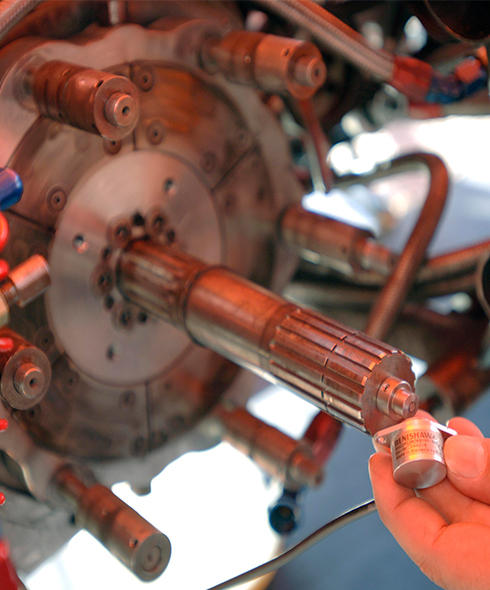Renishaw 編碼器能「駕馭爆燃」
KTM 高速賽車的排氣量僅有 1995 cc,卻擁有 1,500 匹馬力,6.7 秒鐘就能跑四分之一英里(約 400 公尺)遠,最高時速達每小時 316 公里。在 Stanley Kubrick 的經典影片《奇愛博士》中,Slim Pickens 騎著炸彈從飛機中飛了出去。如果他駕駛的是一輛摩托車,那麼這一定是芬蘭 Salakazi 賽車隊製造的 KTM 硝基甲烷燃料高速賽車。協助馴服 KTM(難以控制的)爆燃問題的功臣是 Renishaw RM22 緊湊型高速磁性旋轉「防爆」編碼器。
打破速度紀錄
一位以打破速度紀錄著稱的勇敢芬蘭人,驅動著擁有驚人動力輸出的 360 公斤重的摩托車,一切都發生得這麼快。
瞬間,引擎的轉速就達到了每分鐘 7,500 轉。觀眾還沒看清發生了什麼,比賽就已結束,摩托車和賽車手已經跑完四分之一英里,正在緊急刹車呢。就摩托車比賽而言,這是再簡單不過的了。比賽的目標是在最短的時間內從 A 點直線到達 B 點。
Jaska Salakari 是第一個駕駛歐洲最快的雙渦流硝基甲烷燃料 (Super-Twin Top Fuel) 摩托車,打破 7 秒四分之一英里紀錄的芬蘭人,他擁有 Salakazi 賽車隊。癡迷於速度的六人車隊由全職和兼職人員組成,自 2000 年以來,該車隊一直駕駛著自行設計和製造的 KTM 雙渦流高速賽車。
在加速賽中,反應時間是以毫秒計的,僅靠飛轉的後輪永遠也不可能贏得比賽。除非功率能有效地轉化成快速的前進運動,否則再大的功率也無濟於事。駕駛員(或「乘客」?)幾乎沒有思考的時間,更不用說踩下、鬆開普通的離合器踏板了。駕駛員更不可能準確確定達到最佳牽引力所需的離合器接合速度。
Salakazi 賽車隊給 KTM 高速賽車配備了裝有 Prowork 數位控制器的 Prowork 三盤四檔自動離合器。當駕駛員開啟油門時,控制器按照預定程式與離合器接合。這正是旋轉位置編碼器發揮作用的時候 — 它們可監控高達 30,000 rpm 的轉速。這些微小而關鍵的裝置,有一個在監控引擎曲軸的位置,而其他則在量測離合器的速度。
降低功率
通過比較編碼器提供的量測資料,可以精確地測定離合器的滑動、牽引和路況。這些資料對車隊非常重要,有了它們,技師便可在賽前正確地調節離合器中的第一級平衡重。
每次比賽的賽道和摩托車狀況都不同,但是每次比賽後 Renishaw 編碼器採集並編輯的重要資料都可以用來對控制器進行編程,以儘量達到最佳離合器接合。賽車可以在最初的零點幾秒內以最少的車輪轉動達到最大的速度和加速度。
Salakazi 賽車隊中自稱為「技術權威」的 Petri Mäkinen 很快指出,Renishaw 提供的方案和牽引控制系統不同。他說,主要是因為離合器在比賽之前就已經用控制器設定的值進行了調節。
「Renishaw 編碼器不是在行駛中動態地控制離合器,」他解釋說,「但是它事先提供的資料極其重要。我們不可能以其他方式獲得這些資料,並預設離合器。
我們需要在後輪旋轉完一圈以前讀取離合器速度,以作出接合離合器的決定,而且加速是不平穩的。現在這一問題已得到解決,並且程式碼已進行了適當的過濾。下一賽季,Renishaw 編碼器還將用於控制提前點火,在未來幾年內,我們還將使用編碼器調節凸輪。
Mäkinen 使用這些資料取得最大的引擎有效功率,並推動 Salakari 在極短的時間內加速到每小時 300 公里以上的速度 — 比閱讀此段文字所用的時間還短。由過去的表現來看,這些資料發揮了關鍵作用。
Renishaw 編碼器不是在行駛中動態地控制離合器,但是它事先提供的資料極其重要。我們不可能以其他方式獲得這些資料,並預設離合器。
Salakazi(芬蘭)
爆燃極限
Renishaw 旗下 RLS 公司推出的 RM22 磁性編碼器專為極嚴苛環境下的無故障運作而設計,但是 Salakazi 賽車隊選定的編碼器安裝位置對於任何電子設備來說都是難度極大的。
Mäkinen 指著一個部分拆卸的引擎曲軸的末端,有點俏皮地笑著說:「這就是我們安裝 Renishaw 磁性致動器的地方。我們直接把它安裝在曲軸的末端。編碼器本體在另一側的離合器殼體中。老實說,我認為對編碼器來說,除了太空火箭外,沒有比這個環境更嚴苛的了。」
RM22 由 Renishaw 在斯洛維尼亞的關聯公司設計和製造,抗污染、抗碎屑能力達到 IP68 標準。但是,編碼器的最高工作溫度是 125°C,如何讓編碼器在極高的離合器溫度下正常運作呢? 對此 Mäkinen 作了詳細說明。他說,秘密在於將編碼器放在厚重的機加工鋁殼中。
「編碼器直徑只有 22 mm,因此可以放入離合器殼內而不影響零件的強度。離合器是可能會爆燃的,他補充說,「我曾見到過好幾次爆燃,所以離合器殼對於駕駛員的安全非常重要。如果編碼器再大一些,我們就得重新設計解決方案。」
RM22 具備非接觸兩件式的設計特點,無需軸承或密封件,安裝和拆卸快捷、簡單。
「每次比賽後我們的機械師都會冷卻離合器並迅速拆下殼體和編碼器,」Mäkinen 說,「比賽過程中厚重的鋁殼體確保編碼器不受熱。在編碼器還沒有受熱到超過規格之前,我們已經將賽車帶回維修產線並拆除了編碼器。」
比賽一場接一場,操作都很可靠
在高速賽車這種複雜的機器中安裝的任何零組件都必須又好又可靠。Mäkinen 對 Renishaw RM22 編碼器讚賞有加,這個微小而關鍵的零件已經證明自己超越了公佈的規格要求。
「在這樣的條件下,Renishaw 編碼器的可靠性真是令人驚奇。沒有它們,我們只能估計引擎和賽道的重要資訊,」他說,「但是如果你想打破紀錄,光有估測是不夠的。」

